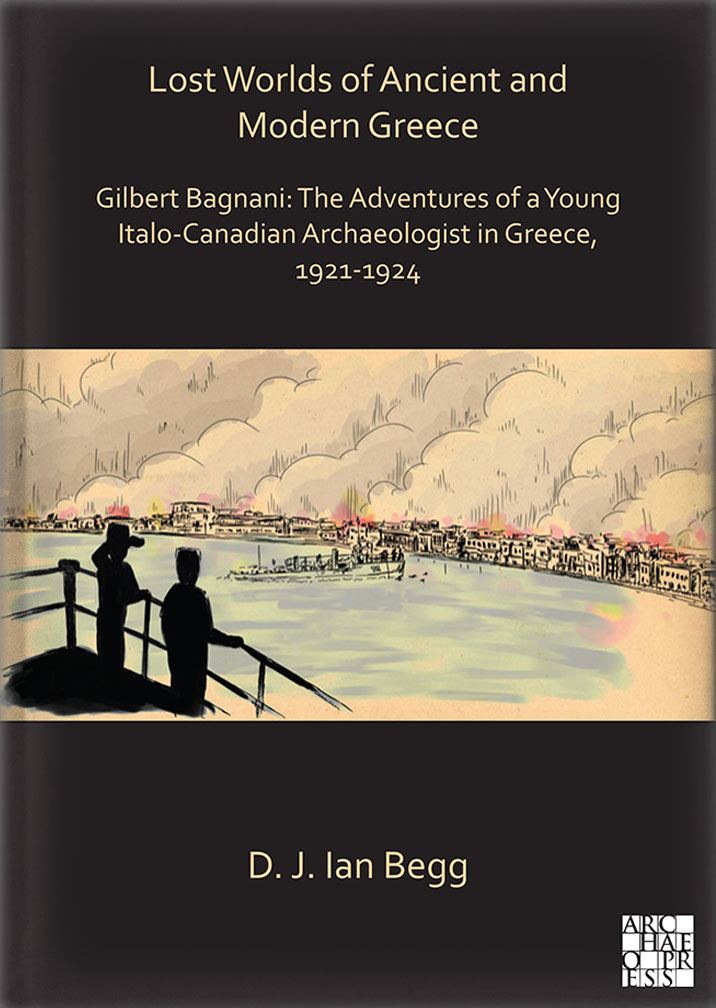The titles of some books act like magnets. They pull you towards them and command attention. The title of the book under review Lost Worlds of Ancient and Modern Greece did just that. It is not about the lost worlds of Ancient Greece alone but also about the lost worlds of Modern Greece. Then you read the secondary title: Gilbert Bagnani: The Adventures of a Young Italo-Canadian Archaeologist in Greece, 1921-1924. Who is Gilbert Bagnani and what adventures is he having in Greece before and after the Asia Minor Catastrophe?
Any hesitation you may have had vanishes into thin air when you start reading this absorbing, literate, informative and simply wonderful book.
Gilbert Bagnani, the subject of Ian Begg’s book, was unknown to me, and I am glad to have made his acquaintance. The book covers the period 1921-1924. Gilbert comes across as a fascinating character, who encountered the Levant at a critical time for both the Greece of Eleftherios Venizelos and the Turkey of Mustapha Kemal Atatürk. He was bilingual in Italian (from his father) and English (from his mother): an archaeologist but always more than that. He knew and was helped by the excellent William Miller, which led to his contributing incisive articles about the politics of Greece and the Levant to the Morning Post in London. As a member of the Italian School of Archaeology in Athens he travelled around Greece and the islands and found himself in Asia Minor at a critical phase of the Greek occupation and Kemal’s war of independence. All this and much more is described in Gilbert’s letters to his mother. His grasp of local and international politics was impressive. He and Begg paint sparkling pen pictures of personalities such as Bosdari, the Italian ambassador during the Great War, and later Governor of the Dodecanese, Prince Demidoff the Russian ambassador, Harold Lamb the British Consul at Smyrna and family, Greek personalities such as Stratos, Kalapothakis, Karapanos, and colleagues at the Italian School. Gilbert emerges as clever, sometimes arrogant, fascinated by people especially from high society, and with a weakness for royalty. Begg does him justice in a well sourced book. This is a lively account of a formidable personality, scholar and archaeologist in the making. The black and white photographs by Gilbert himself are excellent.
—Sir Michael Llewellyn Smith, British Ambassador to Greece 1996–1999
Gilbert Bagnani, of Italian and Canadian extraction, arrived in Greece at the age of 21, already well-connected through his parents’ social and professional circles. He was ostensibly studying Greek Archaeology and participating in fieldwork, research and assisting with educational trips for the Italian and other Western archaeological institutes in Athens. However, secretly, he was sending well-informed reports on the dynamic political situation in Greece and between Greece and Turkey to a London newspaper, while later spying for Mussolini. This first of three volumes based on his personal letters and news’ reports covers the momentous years from 1921-1924, which witnessed the disastrous failure of the Greek invasion of Western Turkey, the sack of Smyrna, a military coup and executions in Greece. We are also treated to highly-entertaining sketches of leading archaeologists in Greece, and the way fieldwork was conducted, as well as the social life of the political class and wealthy elite of Athens – into which, despite his youth, he quickly found a niche, thanks to his family connections and obvious social graces. Informative, excellently-edited and a delight to read.
—Professor John Bintliff, Edinburgh University
This book stands as a major contribution—and an accessible one—to our understanding of the history of Greece in the years 1921-1924. In bringing Gilbert Bagnani back to life through his subject’s letters and through his own careful delving into primary sources, Ian Begg joins a group of scholars (among them Natalia Vogeikoff-Brogan, Jack L. Davis, Susan Heuck Allen, Kostis Kourelis, Artemis Leontis, Despina Lalaki) who have examined the personal lives, attitudes and idiosyncrasies of archaeologists, artists and performers, anthropologists, and historians as entryways into the discoveries they made, using their personalities as lenses for their scholarly or artistic methods. Such approaches by later generations of scholars shed fresh light on the work of their predecessors and enlarge our understanding of the histories they wrote or performances they created.
—Robert Pounder, Bryn Mawr Classical Review
It is D. J. Ian Begg’s great achievement that, in preparing his many-layered book with all its rich detail, he has made the century-old Bagnani archive accessible to a much wider audience. The author has compiled a book in which there is, throughout, a feeling of impending disaster. Drawing on the multi-talented Bagnani’s extensive body of letters to his Canadian mother, who was living at that time in Rome, he creates a powerful narrative that probes the young man’s response to the situation in which he found himself. At the same time, he paints a picture of a crucial period in Greek history as experienced on a day-to-day basis by a young archaeologist.
—Leonie Breeds, “Portrait of an Archaeologist as a Young Man,” ARGO 13, Spring / Summer 2021, 63-64


